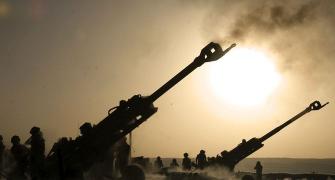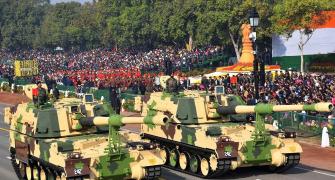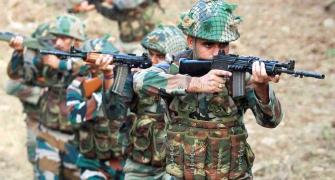The artillery pounds targets and keeps the enemy's head down, preventing them from firing at attacking troops.
Ajai Shukla reports.

In an important step towards upgrading the combat power of the artillery, the Ordnance Factory Board on April 8, 2019, handed over the first six Dhanush 155 millimetre artillery guns to the army.
This is part of an order for 114 guns being delivered by the OFB's Gun Carriage Factory in Jabalpur.
The Dhanush is also called the 'Desi Bofors', having been developed from blueprints supplied by Bofors in the 1980s, when India bought 400 Swedish FH-77B howitzers (or, interchangeably, guns).
Embroiled in scandal, the Bofors manufacturing blueprints were never used.
Only after the gun proved its worth in the Kargil conflict did the United Progressive Alliance encourage the OFB to upgrade the 155 millimetre/39 calibre gun to 45 calibre and manufacture it in numbers for the army.
The National Democratic Alliance government has taken this forward, putting the Dhanush through rigorous trials to meet the army's requirements.
MoD sources say the gun has fired over 4,500 rounds in trials.
The bore of an artillery gun -- in this case, 155 mm -- represents the internal width of the barrel and governs the weight of explosive packed into each shell -- its destructive power.
The calibre -- 39/45/52, as the case may be -- governs the length of the barrel, which, in turns, affects its range.
The longer the barrel, the longer the range, allowing guns to fire from so far that the enemy cannot respond.
In upgrading the 39 calibre Bofors FH-77B to a 45 calibre Dhanush, the OFB has effectively increased the gun's range.
It has also increased the indigenisation content to 81 per cent, which would be boosted as production stabilises.
The Defence Acquisition Council has cleared the purchase of 414 Dhanush guns, but the army is placing orders in tranches so that the OFB can continue refining the gun.
Artillery is a key combat enabler and has been the primary killer in every major battle since the American civil war.
The artillery supports an attack by pounding the target and keeping the enemy's head down, preventing them from firing at attacking troops.
While supporting the defence, artillery seeks to cause casualties on attackers in the open.
Overall, the army has 218 field artillery regiments that are equipped with guns like the Dhanush.
With practically no artillery being bought since the 1980s owing to the ghost of the Bofors scandal, more than half of these are equipped with light field guns, of 105 and 130 calibre, which damage the target less effectively than the 155 mm guns that the army has now chosen as its standard bore.
That requires the urgent replacement of light field guns with about 110 regiments.
With each regiment authorised 20 howitzers, that demands the procurement of about 2,200 guns.
Furthermore, since the existing 155 mm guns are also decades old, another 2,200 guns are needed to replace them.
After two decades of procrastination, the army is proceeding on four tracks to modernise the artillery.
The first breakthrough came with the purchase of 145 M777 ultralight howitzers from BAE Systems Inc for about $700 million.
The first batch of M777 guns was handed over to the army at Deolali on November 9, 2018 and the rest are being manufactured.
These light, agile guns will equip seven artillery regiments in the north east, where the shortage of roads and tracks make its portability extremely useful.
With the induction of the Chinook helicopter last month, the M777 can now be shifted rapidly between high-altitude gun positions by slinging them under the Chinook's belly.
Also inducted was the first batch of K-9 Vajra self-propelled howitzers, which Larsen & Toubro is building outside Pune with technology from South Korea.
These heavy, 155 mm, 52 calibre SP guns are mounted on tracked, armoured chassis, so that they can accompany and provide fire support to tank columns of the strike corps that operate in the plains and deserts of the western sector.
Just 100 SP guns are being bought, mainly for the desert formations of the army's Southern and SouthWestern Command.
The Western command can do without these guns, since its operational area is in the Punjab and J&K, where road and track networks are better.
Simultaneously, a 'Buy & Make (India)' acquisition process is under way for 1,580 towed guns that will also be 155 mm, 52 calibre.
The plan is to buy 400 guns off-the-shelf and then build 1,180 in an ordnance factory with transfer of technology, at the rate of 100 guns per year.
Israeli firm, Elbit, has been identified as the lowest bidder and a defence ministry cost negotiation committee is finalising the price.
The Kalyani Group will be the Indian offset partner.
While these four procurements will provide howitzers to replace the 105 and 130 mm guns, the Defence Research & Development Organisation is leading an ambitious public-private partnership to develop an indigenous howitzer called the Advanced Towed Artillery Gun System.
Two private sector firms are partners to the DRDO: The Kalyani Group and Tata Advanced Systems Ltd.
"The ATAGS is coming up as a very accurate, powerful, long-range, consistent gun with a high rate of fire and an all-electric drive," says a senior general, giving a rare military thumbs-up to a weapons system still in development.
While the ATAGS has broken world records in range, a challenge that remains is to reduce the gun's weight from the current 18 tonnes.
Success will be gauged during 'user-assisted technical trials' this summer.











